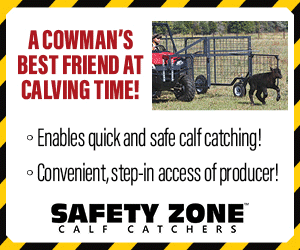Don’t let them squirm their way into your herd
By Rhonda McCurry with Tim O’Byrne
When it finally rains ranchers are grateful for the benefits of the always-needed moisture. The downside is that rainfall and wet seasons increase the number of flies and parasites for livestock grown in the area.
Mark Alley, technical service veterinarian with Zoetis, says ranchers must spend time consulting with their local veterinarian on parasite control no matter whether it’s a wet or dry year. Fly and pest control can have a huge financial impact on the overall health program in an operation, he says.
And, following a wet fall and winter, the spring pastures are abundant with moisture. In some places standing water is happening where it’s not happened before. Alley says anytime there is standing water and mud the impact on the animal can be significant, not only from the additional energy requirements of the cow but also hose animals are more prone to foot rot, parasite problems and other disease situations.
Cold temperatures, he says, doesn’t mean parasites are killed off.
“Specifically on internal parasites, it rarely ever gets cold enough to kill parasites,” Alley says. “Probably the biggest environmental impact on larvae for most nematodes is actually when it becomes really dry.
Even northern tier states do not see temperatures cold enough to actually impact parasite growth. Depending on the species of parasite, Alley says some of those infected larva can live for 19 to 20 months. In Canada, he adds, many researchers have stopped working on the cold-kills-parasites theory because the temperatures are not frigid enough to truly impact parasites to a significant degree.
If an area has had hot dry weather followed by some rain, Alley says, is when ranchers see the most problems. To stave off a parasite epidemic in the herd, ranchers should work with their vet to make smart decisions.
Internal parasites can have negative impact on production as well as immune responses. Parasites can suppress immunity to the point where cattle are not responding like they should to vaccines and thus, are not protected from disease.
Alley says, “The challenge is some dewormers especially endectocides are not as effective as we would like them to be against parasites like Cooperia and Nematodirus. You may have to use white dewormers to do a better job of controlling those parasites.”
Cooperia and Nematodirus can be more common in much younger calves. When they are exposed for very first time, they are more susceptible. As animal gets older, Alley says, it can develop natural resistance to Cooperia and Nematodirus so these parasites are not as much of a problem in older cows.
Alley says that somewhere around two to four months is the beginning of when calves might get some nutrition from pasture. Prior to this most of their nutrition comes from mom’s milk. If environmental conditions are right, with temps above 40 degrees and moisture, calves can easily pick up a parasite load and have problems.
Alley says typically an older cow does a good job of adapting to parasites as long as she has plenty to eat. His advice for ranchers who want to improve an animal’s ability to utilize whatever nutrients they’re taking in is to focus on three groups: calves around the time of weaning, heifers preparing for breeding, and stockers.
“We all need to be aware of how best to incorporate refugia* into practices that minimize pasture contamination and also have parasites be susceptible to dewormers later,” Alley says. “It’s a very complicated topic.”
Consult your veterinarian to create a comprehensive deworming strategy specific to your herd.
*refugia – A complex strategy that involves ensuring that a segment of the worm population living in the cowherd that is not resistant to deworming products remains untouched and are allowed to breed. In essence, a “refuge” is created for them. Why not just kill them all? The strategy is based on the theory that if these refugia worms are allowed to reproduce, the resistant worms will not take over the herd completely and become the dominant segment. Consult your veterinarian.
Larvae Low-down
By Tim O’Byrne
Internal parasite larvae love moisture. That’s when they thrive, and as grass grows they stealthily make their way up the blade, hoping an unsuspecting critter comes along to give them a ride to the perfect environment in which they can do the most damage…the bovine digestive tract.
That parasites literally eat into a beef producer’s wallet is obvious, but what bothers most of us more is the actual harm they do to the cattle we care for every day.
The Brown Stomach Worm, Ostertagia ostertagi is the big gorilla in many parts of the United States when it comes to internal parasites. When the cow ingests the larvae, it embeds around the glands that produce acid in the abomasum segment of the cow’s stomach system (the final of four segments that connects directly to the small intestine).
“The damage to those glands reduces the ability of the animal to digest properly,” explains Dr. Doug Ensley, professional services veterinarian for Boehringer Ingelheim Vetmedica, Inc. “The biggest thing about Ostertagia is that it reduces their appetite. Plus, it’s painful, it’s uncomfortable, and it’s kind of like a person having an ulcer. Your stomach hurts.”
If this little brown unwanted guest is left to its own devices, the herd starts to head in a direction we don’t want them to go. Emaciation, poor scraggly hair coat, general depression and, in worst cases, fluid buildup in the jaw and brisket, diarrhea and eventually death.
But Ostertagia is no one-trick pony, Dr. Ensley warns. In fact, it has quite a nasty little Ace up its sleeve.
“Ostertagia larvae doesn’t like a lot of summer heat. It doesn’t like cold either, but their ability to lie dormant in the abomasum of the cow and not lay eggs until the outside environment is favorable to them is the big reason why producers need to make sure that keeping on top of their emergence is a high priority.”
How do we keep up on them? Dr. Ensley suggests taking fecal samples before worming
“What I really want people to do is sit down with their veterinarian and try to look at their parasite control practices and see if they are really working,” advises Dr. Ensley. “Before you deworm, pull fecal samples and find out what kind of parasite load you’re dealing with, and understand when your herd is most susceptible to those parasites. Get a handle on the timing in your area, when’s the best time to deworm your cattle…maybe spend a little money to do a Fecal Egg Count Reduction Test where you come in two to three weeks later after you dewormed and see if you have a 90% reduction in the parasite load within those animals.”
No Fluke
Another potentially devastating actor in beef production’s parasite horror flick is the Liver Fluke. This tiny leech-like organism can cause a lot of pain and damage to a healthy cow liver. It has a rather strange life cycle – the larvae enter a snail in a moist environment, mature there for awhile, then release themselves and migrate to grass or marshy areas where they wait to be ingested by a cow. Once in the cow’s small intestine, they spring into action, boring their way painfully through the liver to get to the bile duct, where they release eggs that make their way back to the cow’s gut and exit through the manure to complete the cycle.
“With standing water back on the land after a period of drought, those flukes and snails are more likely to be present now where they weren’t before,” Dr. Ensley explains, mentioning that the Southeast US, particularly Florida, knows all about these terrible parasites. “Producers are going to have to think about the time frame; if you’re affected with liver flukes right now, you’re going to want to start thinking about adding a flukicide to your deworming strategy in the fall so that you start cleaning those flukes up.”




